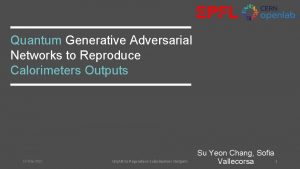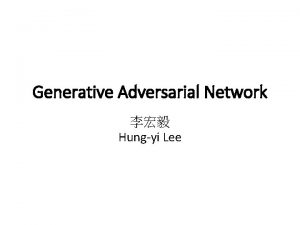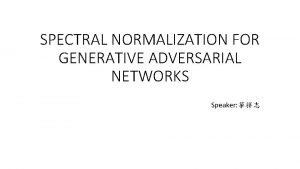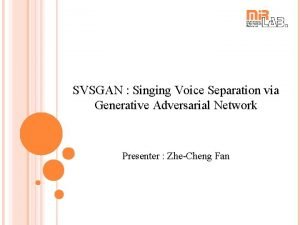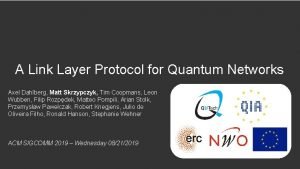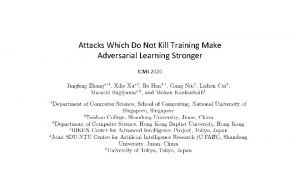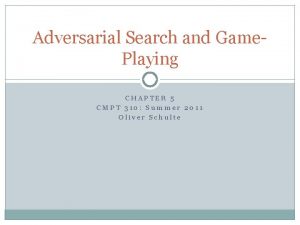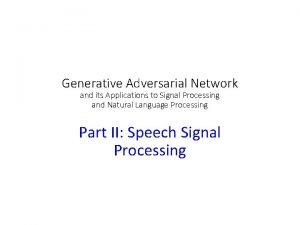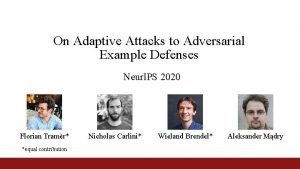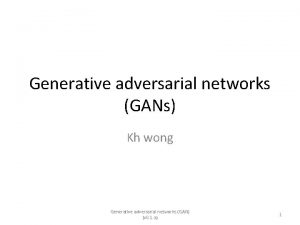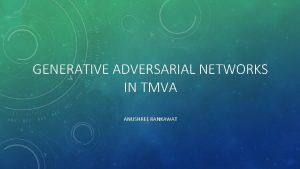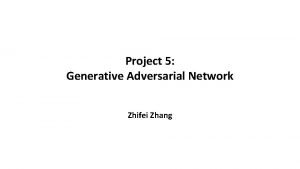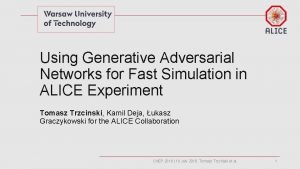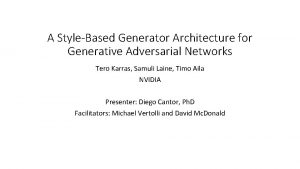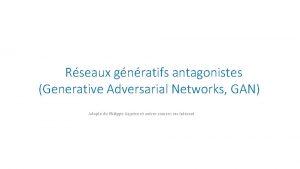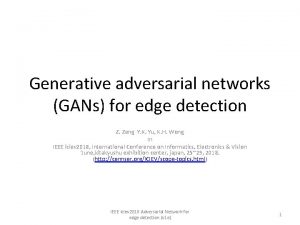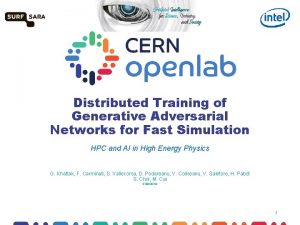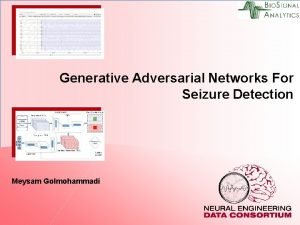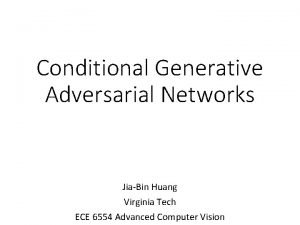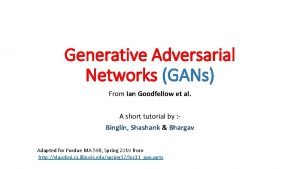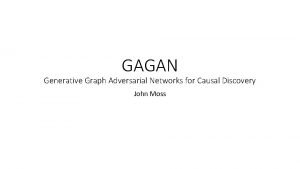Dual PQC Quantum Generative Adversarial Networks to Reproduce



















- Slides: 19

Dual PQC Quantum Generative Adversarial Networks to Reproduce Calorimeters Outputs 12 June 2021 Dual PQC QGAN to Reproduce Calorimeters Outputs Su Yeon Chang, Sofia 1 Vallecorsa

Motivation ü Calorimeters outputs used to understand low distance processes occurring during the particle collision ü Tremendous amount of time required by Monte Carlo based simulation to reconstruct outputs → Generative Adversarial Networks for fast simulations ü Development on Quantum Machine Learning using compressed data representation in quantum states Dual PQC QGAN to Reproduce Calorimeters Outputs

What is Generative Adversarial Network (GAN)? ü ü https: //dl. acm. org/doi/proceedings/10. 5555/2969033 Generative model with two neural networks : Generator : Generates fake output from random input Discriminator : Classify fake and real data Play on minmax game with value function V Likelihood to assign correct label to real samples 12 June 2021 Likelihood to assign correct label to generated samples QGAN to Reproduce Calorimeters Outputs 3

Quantum Generative Adversarial Networks ü Based on QGAN model constructed by IBM (https: //doi. org/10. 1038/s 41534 -019 -0223 -2) ü Hybrid model : Quantum Generator + Classical Discriminator ü Efficient in loading and learning a probability over discrete values ü More qubits → Higher resolution 12 June 2021 QGAN to Reproduce Calorimeters Outputs 4

Application of GAN in HEP Two-dimensional projection of 3 D energy shower → Reproduced by 2 D version of 3 DGAN 12 June 2021 QGAN to Reproduce Calorimeters Outputs 5

Application of of QGAN in in HEP 1 D energy distribution 12 June 2021 QGAN to Reproduce Calorimeters Outputs 6

Application of QGAN in HEP (3 Qubits) Depth 3 & Normal initialization 12 June 2021 QGAN to Reproduce Calorimeters Outputs 7

Limitation ü No exponential advantage proved yet ü Limited in reproducing an average probability distribution over pixels ü Aim to reproduce single image per run 12 June 2021 QGAN to Reproduce Calorimeters Outputs 8

Dual PQC GAN model ü Role of generator shared by two Parameterized Quantum Circuit (PQC) → PQC 1 : Reproduces distribution over 2 n images → PQC 2 : Reproduce pixel intensities over one image of 2 n pixel n 2 - n PQC 2 n 2 qubits n Reproduce 2 n images of 2 n pixels PQC 1 n 1 qubits Classical Parameter optimization Dual PQC QGAN to Reproduce Calorimeters Outputs Discard Discriminator

Unitarity Issue Why do we need n 2 > n ? ü Quantum Circuit consists of reversible gates → Unitary matrix, i. e. all columns should be orthonormal → Cannot train PQC 2 with n qubits if the images do not form an orthonormal basis Easiest case → Use n 2 = 2 n Dual PQC QGAN to Reproduce Calorimeters Outputs

Code Implementation Application of QGAN in HEP Generator Classical Discriminator ü Py. Torch Discriminator ü 4 nodes → 512 nodes → 256 nodes → 1 node ü Leaky Re. Lu between hidden layers and sigmoid at the end ü AMSGRAD optimizer ü Gradient penalty for stability and convergence 12 June 2021 QGAN to Reproduce Calorimeters Outputs 11

PQC 1 test of QGAN in HEP Application PQC 1 + Discriminator similar to 1 PQC qgan model → Each output state assigned to one image (one mean image values for each class) 12 June 2021 QGAN to Reproduce Calorimeters Outputs 12

PQC 2 test of QGAN in HEP Application 12 June 2021 QGAN to Reproduce Calorimeters Outputs 13

PQC 2 test of QGAN in HEP Application ü Images of size 4 ü Harder to train even with depth = 14 12 June 2021 QGAN to Reproduce Calorimeters Outputs 14

Results for dual PQC model n = 2, n 1 = 4, n 2 = 4, depth 1 = 2, depth 2 = 16 Dual PQC QGAN to Reproduce Calorimeters Outputs

Results for dual PQC model n = 2, n 1 = 4, n 2 = 4, depth 1 = 2, depth 2 = 16 Dual PQC QGAN to Reproduce Calorimeters Outputs

Results for dual PQC model Real n = 2, n 1 = 4, n 2 = 4, depth 1 = 2, depth 2 = 16 Generated Dual PQC QGAN to Reproduce Calorimeters Outputs

Results for dual PQC model Dual PQC QGAN to Reproduce Calorimeters Outputs

Conclusion ü Dual PQC GAN model has potential to imitate classical GAN model. ü Difficulty in stabilizing PQC 2 → Problem in the definition of loss? ü Expect better result with different parameters? Dual PQC QGAN to Reproduce Calorimeters Outputs
 Quantum generative adversarial learning
Quantum generative adversarial learning Generative adversarial networks
Generative adversarial networks Melody randford
Melody randford Spectral normalization gan
Spectral normalization gan Singing
Singing Rework flow
Rework flow Nist pqc
Nist pqc Corn fungicides brands
Corn fungicides brands Quantum physics vs quantum mechanics
Quantum physics vs quantum mechanics Quantum physics vs quantum mechanics
Quantum physics vs quantum mechanics A link layer protocol for quantum networks
A link layer protocol for quantum networks Backbone networks in computer networks
Backbone networks in computer networks Datagram network diagram
Datagram network diagram Adversarial training
Adversarial training Friendly adversarial training
Friendly adversarial training Adversarial patch
Adversarial patch Adversarial search problems uses
Adversarial search problems uses Adversarial stakeholders
Adversarial stakeholders Adversarial training
Adversarial training On adaptive attacks to adversarial example defenses
On adaptive attacks to adversarial example defenses
